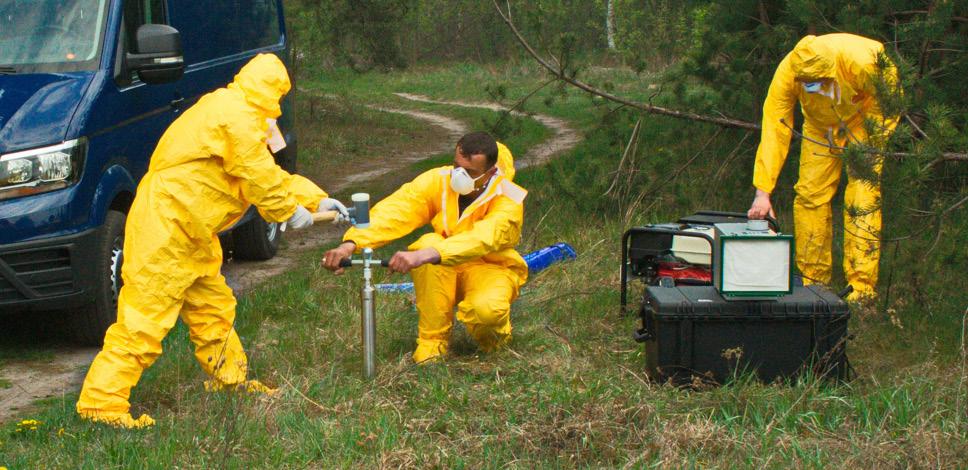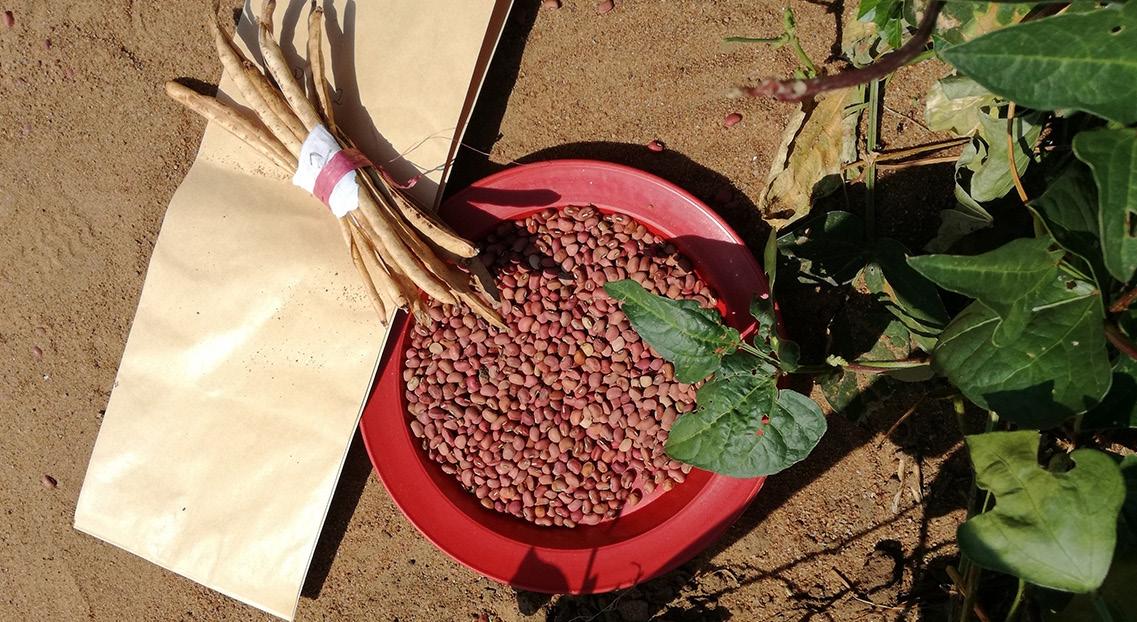
10 minute read
IAEA News
from Infectious Diseases
by IAEA
Belarus receives IAEA equipment to assess radiological threats associated with forest fires
Crew of the new mobile laboratory during a practical training exercise for soil and air sampling in the Chornobyl Exclusion Zone in May 2020. (Photo: R. Nenashev/Polessye State Radioecological Reserve, Belarus)
When forest fires occur on sites with significantly elevated radiation levels, such as the fires that broke out in the ChornobylExclusion Zone, which straddles the border between Belarus and Ukraine, in April 2020, officials and the public want to know whether there is an elevated risk of radiation exposure. While there was no such risk posed by theseries of wildfires in northern Ukraine in the exclusion zone, just 16 kilometres from the Belarusian border, new equipment sent to Belarus by the IAEA will better prepare scientists for radiation monitoring in the future.
Forest fires are recurring events in the abandoned areas of the exclusion zone, a 4760 square-kilometre area surrounding the nuclear power plant that has mainly been uninhabited since theChornobyl nuclear accidentin 1986. In such circumstances, sound scientific data is needed to ensure the appropriate response and to protect the health of both the public and directly affected personnel, such as firefighters, forest workers, border guards, scientists and technicians working in the zone.
Responding to Belarus’ request, the IAEA helped to design and procure a mobile laboratory in the country, complete with instruments and tools for radiation monitoring of the air and environment.
“The dedicated work of IAEA specialists and Belarusian counterparts allowed for the design and delivery of a well-equipped and fit-for-purpose mobile laboratory to support Belarus in its prompt response to current radiological threats posed by forest fires in the exclusion zone,” said Peter Swarzenski, Acting Director of the IAEA Environment Laboratories.
The mobile laboratory can be taken on off-road operations and serves as a work station for a crew of four in the field. It is equipped with a portable air-sampling device, a handheld gamma spectrometer, a radiation monitor for measuring environmental samples, a soil-sampling kit, personal protective equipment, navigation and communication tools, an electric generator and a workplace with a computer and other appliances.
The air samples collected at the sites of forest fires need to be analysed to accurately determine the activity of radioactive isotopes of caesium, strontium and transuranium elements.
The assistance provided to Belarus by the IAEA is taking place as part of a technical cooperation project launched in 2018, which has been primarily focused on helping the scientific and technical staff of the Polessye State Radioecological Reserve in Belarus to advance their professional knowledge and skills, particularly in relation to the dosimetry of inhalation intake of radionuclides, as well as the identification and procurement of appropriate instruments, tools and
consumables for radiation monitoring, air and soil sampling, and sample processing and measurements.
“Along with the mobile radiological laboratory, the IAEA has made a significant contribution to strengthening our activities in the fields of research and radioactive pollution monitoring through training activities, scientific visits and the procurement of necessary equipment and supplies. This is just what we need in this period,” said Mikhail Patsiomkin, Chief Specialist at the Belarusian Ministry of Emergency Situations. Two new varieties of cowpea, a crop that provides a major source of protein for people in Zambia, are being released to offer significantly improved yields and quality to farmers and local communities. The new varieties of cowpea, a grain legume that is predominantly cultivated in Africa, mature earlier and therefore require less water, allowing them to better withstand drought. They produce higher yields than local varieties under drought conditions and have also demonstrated better
Scientific data supports better communication with local populations
Along with the collection and analysis of data, communicating information to the local population is a crucial component of emergency response when forest fires are burning a few kilometres away from their communities.
“When assessing radiological challenges and threats during the recent fires in the Ukrainian part of the exclusion zone, the media took into account the opinion of the Polessye performance than local varieties in the face of certain diseases and pests. Developed using nuclear technologies, seeds of these cowpea varieties will be available to farmers in late 2020. The IAEA, in partnership with the Food and Agriculture Organization of the United Nations (FAO), works to improve food security worldwide by using nuclear science. Through this partnership, plant breeding programmes are carried out with the use of nuclear technologies, resulting State Radioecological Reserve, which was strengthened by IAEA technical and scientific support. As a result, information published in the Belarusian mass media was mostly reliable and based on an authoritative opinion,” said Patsiomkin.
As of May 2020, the IAEA technical cooperation project is approaching completion, and Belarus is now well equippedto assess radiological threats that may arise from forest fires in the future.
Drought-tolerant crops: IAEA and FAO help Zambia improve production and farmers’ income
— By Elodie Broussard in the production of more crops with improved characteristics.
“Crop production in much of Africa, including Zambia, is hindered by heat, drought, pests and diseases, to the point where some farmers cannot grow enough food,” said Fatma Sarsu, a plant breeder and geneticist at the Joint FAO/IAEA Division of Nuclear Techniques in Food and Agriculture. “Increased drought in recent years, as well as the effects of climate change, are amplifying the challenges farmers
Kalaluka Munyinda, Lecturer at the Department of Plant Science, stands in the experimental field for growing new plant varieties at the University of Zambia. (Photo: University of Zambia)

already face. Developing improved crop varieties through plant breeding is one way to address this issue.”
The two new cowpea varieties, called Lunkhwakwa and Lukusuzi, were developed using irradiation, a technique which speeds up the natural process of producing genetic variation in plants. The crops are currently being multiplied, and the seeds will be distributed to 800 farmers in November 2020 for planting.
“We are primarily targeting farmers in the dry areas of the country, who have had trouble growing enough food in recent years due to the extremely dry conditions,” said Kalaluka Munyinda, Lecturer in the Department of Plant Science of the University of Zambia. “The challenges these farmers faced were crucial problems that we needed to address with mutation breeding. Additionally, as these new varieties are also more tolerant to diseases, we are planning to eventually grow them in high-rainfall areas as well, where yield losses resulting from disease are a bigger threat to famers.”
To meet farmers’ demand for desired crop characteristics, scientists at the FAO/IAEA Agriculture and Biotechnology Laboratory in Seibersdorf, Austria, subjected the seeds of local varieties to gamma irradiation, inducing changes in their genetic make-up. Following this, the irradiated seeds were sent back to Zambia, where they were planted in test fields to observe their characteristics under local conditions. During the testing process, farmers worked alongside scientists to select improved plants.
“We have been badly impacted by droughts over the past two years between 2018 and 2020, and crops have not been performing well here, but now we have varieties that do well with little rainfall,” said a farmer from the Chirundu District in southern Zambia. “Initially, we only had one variety of cowpea that was late maturing, but now we have access to new varieties that are early maturing. We want to build a community that is climate-resilient by increasing the number of varieties grown in our community.”
The project is expected to lead to increased food security as well as higher incomes for farmers. “In some locations, the new varieties are up to ten per cent higher yielding than the parent varieties, which means that farmers will not only be able to grow more food, but also increase their income,” said Munyinda. “These varieties are also more tolerant to diseases such as Ascochyta blight, which severely inhibit yields in some areas. As a result, we are expecting to improve national food security in terms of both increased availability of food and improved nutrition.”
— By Carley Willis
New varieties of cowpea plants are helping many farmers around Africa grow more food despite drought. (Photo: Prince M. Matova/Crop Breeding Institute, Zimbabwe)

IAEA provides standards to help laboratories measure changes in the environment
In 2020, the theme of World Environment Day, held on 5 June, was ‘Time for Nature’. Indeed, now is the time to understand the messages that nature is sending through the millions of tiny changes that are beginning to cause major shifts in global ecosystems. The IAEA and its partners have access to nuclear tools that have allowed them to measure these changes with great precision for over 50 years. The resulting datasets and reference materials, which have been accumulated by thousands of scientists in hundreds of laboratories, are now fully available online to the public and policymakers with the aim of developing effective conservation policies. Laboratories around the world can be assured of their performance and their degree of accuracy by directly comparing their results with known standard reference materials that have been carefully measured and quantified. This is why easy access to reference standards is essential for a quantitative and fair assessment of a laboratory’s proficiency. Since the early 1960s, the IAEA has developed and made available a large collection of reference materials for laboratories worldwide to assist them in quality assurance for results they obtained using nuclear analytical techniques. These reference products pertain to reliable and accurate results in studies of environmental radionuclides, stable isotopes, trace elements and organic contaminants. They are available on the IAEA website through the newly upgraded IAEA Reference Products for Environment and Trade web portal, which offers enhanced repository data, improved search capacity and an online system for purchasing certified reference materials. “The modernized website makes it easy to navigate through a comprehensive range of reference products available to our external customers, which helps them to improve and maintain their analytical excellence,” said Manfred Groening, Head of the IAEA’s Terrestrial Environment Laboratory. Organic substances obtained from a wide range of materials, such as fish and oyster powders, rice, grass, spruce needles, moss, cellulose, ancient and modern woods, soil and marine sediment, seawater, distilled water, powdered rock materials (such as obsidian), carbonates, and pure chemicals and gases, are processed at the IAEA Environment Laboratories under strictly controlled conditions. They serve as reference materials for scientific purposes to help laboratories
Carefully handling a sample for analysis. (Photo: IAEA)

investigate and protect the environment. “Regular participation in IAEA proficiency tests and access to reference materials for measurements of radionuclides in the environment are very important to us,” said Hamid Marah, Scientific Director of Morocco’s National Centre for Nuclear Energy, Sciences and Technology (CNESTEN). “This access helps our research centre to demonstrate its analytical excellence and supports our activities to ensure the well-being of the public.”
Over 90 different reference materials for radionuclides, stable isotopes, trace elements and organic contaminants have been made available to the scientific community. Altogether, more than 2000 individual units of these reference materials are distributed to over 600 laboratories every year. In addition, 700 laboratories benefit annually from quality assurance services by receiving several thousand similar dedicated samples through IAEA proficiency tests free of charge, largely handled through the Reference Products for Environment and Trade web portal.
“The IAEA is the world’s largest supplier of matrix reference materials for radionuclides. Some of these reference products, for example those characterized for stable isotope ratios, are at the highest metrological level as international measurements standards,” said Groening.
The upgraded web portal will provide enhanced access to this library of reference materials so that laboratories worldwide can purchase specialized reference materials from the IAEA through a more user-friendly system, as well as register for accompanying proficiency tests. Annually, more than 1000 laboratories in over 70 countries make use of the registered services available through this dedicated system.
— By Jennet Orayeva and John Brittain










